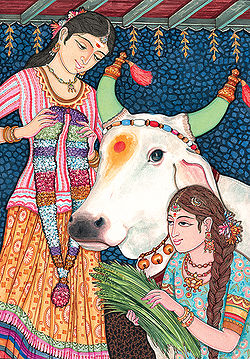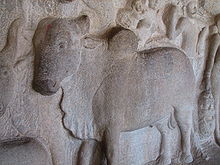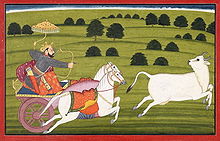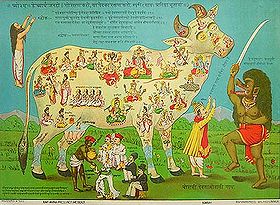- Cattle in religion
-
Cattle are considered sacred in various world religions, most notably Hinduism, Jainism, Buddhism[citation needed], Zoroastrianism as well as the religions of Ancient Egypt, Ancient Greece, and Ancient Rome. In some regions, especially India, the slaughter of cattle may be prohibited and their meat may be taboo.
Contents
In Hinduism
Origins
The cow has been a symbol of wealth since ancient Vedic times. However, they were neither inviolable nor revered in the same way they are today. Some scholars have argued, citing early Hindu scriptures and archaeological evidence, that the cow has not always been sacred and that cows, oxen, and bulls were both sacrificed and eaten in Vedic times and to some extent even later.[1][2]
The cow was possibly revered because the largely pastoral Vedic people and subsequent generations relied heavily on it for dairy products and for tilling the fields, and on cow dung as a source of fuel, fertilizer, and psilocybin mushrooms which naturally grow out of the animal's own excrement. Universally, Hindus still use cow dung for various purposes; the burning of cow dung creates an insecticide to repel mosquitoes, and ash formed from cow dung is used as a fertilizer. Thus, the cow’s status as a 'caretaker' led to identifying it as an almost maternal figure (hence the term gau mata). According to Buddhist texts, there was a Hindu sect taught to imitate a cow's acts for reincarnation to deva.[3][verification needed]
Hinduism is based on the concept of omnipresence of the Divine, and the presence of a soul in all creatures, including bovines. Thus, by that definition, killing any animal would be a sin: one would be obstructing the natural cycle of birth and death of that creature, and the creature would have to be reborn in that same form because of its unnatural death. Historically, even Krishna, one of the most revered forms of the Divine (Avatar), tended cows.
Despite the differences of opinion regarding the origins of the cow's elevated status, reverence for cows appears throughout the major texts of the Hindu religion.[citation needed]
Sanskrit term
The most common word for cow is go, cognate with the English cow and Latin bos, all from PIE cognates *gwous. The Sanskrit word for cattle is paśu, from PIE *peḱu-. Other terms are dhenu cow and uks an ox.
Milk cows are also called aghnya "that which may not be slaughtered".[4] Depending on the interpretation of terminology used for a cow, the cow may have been protected.
The cow in the Hindu scriptures
Rig Veda
Cattle were important to the Rigvedic people, and several hymns refer to ten thousand and more cattle.[5] Rig Veda 7.95.2. and other verses (e.g. 8.21.18) also mention that the Sarasvati region poured milk and "fatness" (ghee), indicating that cattle were herded in this region. RV 6.28 is called Cows. Text 3 speaks about safety of cows.
In the Rig Veda, the cows figure frequently as symbols of wealth, and also in comparison with river goddesses, e.g. in 3.33.1 cd,
Like two bright mother cows who lick their young, Vipas and Sutudri speed down their waters.
The Vedic god Indra is often compared to a bull.[6] Rivers are often likened to cows in the Rigveda.[7] According to Aurobindo, in the Rig Veda the cows sometimes symbolize "light" and "rays".[8] Aurobindo wrote that Aditi (the supreme Prakriti/Nature force) is described as a cow, and the Deva or Purusha (the supreme being/soul) as a bull.[6]
Atharva Veda
Cow's body is represented by various devas and other subjects.[9]
Manusmrti and Mahabharata
In Manusmṛti, speaking in the context of offering sacrificial food offered to ancestors (Pitrs) as Śrāddha; it is mentioned that by offering the food to the cow, ancestors will be satisfied for a ten months.[10] Similarly, in Anushasana Parva (literally: book of instructions) of Mahabharata; Bhishma in his advice to Yudhisthira on Śrāddha, says that a cow presented with rich food, ancestors will be gratified for a full year. This is in comparison to the offer of sesame grains, rice, barley, masha beans, water, roots, and fruits that provides a month's gratification.
Harivamsha
The Harivamsha depicts Krishna as a cowherd. He is often described as Bala Gopala, "the child who protects the cows." Another of Krishna's names, Govinda, means "one who brings satisfaction to the cows." Other scriptures identify the cow as the "mother" of all civilization, its milk nurturing the population. The gift of a cow is applauded as the highest kind of gift.
The milk of a cow is believed to promote Sattvic (purifying) qualities. The ghee (clarified butter) from the milk of a cow is used in ceremonies and in preparing religious food. Cow dung is used as fertilizer, as a fuel and as a disinfectant in homes. Its urine is also used for religious rituals as well as medicinal purposes. The supreme purificatory material, panchagavya, was a mixture of five products of the cow, namely milk, curds, ghee, urine and dung. The interdiction of the meat of the bounteous cow as food was regarded as the first step to total vegetarianism.[11]
Puranas
The earth-goddess Prithvi was, in the form of a cow, successively milked of various beneficent substances for the benefit of humans, by various deities starting with the first sovereign Prithu milked the cow to generate crops for humans to end a famine.[12]
Krishna proclaims: "The piety that comes from bathing at holy places, the piety that comes from feeding brahmins, the piety that comes from giving generous charity, the piety that comes from serving Lord Hari, and the piety that comes from all vows and fasts, all austerities, circumambulating the earth, and speaking truthfully, as well as all the devas, always stay in the bodies of the cows. The holy places always stay in the cows' hooves. O father, Goddess Lakshmi always stays in the cows' hearts. A person that wears tilaka of mud that touched a cow's hoof attains the result of bathing in a holy place. He is fearless at every step. A place where cows stay is holy. One who dies there is at once liberated. One who harms a brahmin or a cow is the lowest of men. He commits a great sin, as if he had killed a brahmin. Of this there is no doubt. A person who harms the cows or the brahmins, who are the limbs of Lord Narayana, goes to hell for as long as the sun and moon shine in the sky."[13]
Kamadhenu, the miraculous "cow of plenty" and the "mother of cows" in Hindu mythology is believed to represent the generic sacred cow, regarded as the source of all prosperity.[14] All the gods are believed to reside in her body; a form of Kamadhenu often depicted in poster-art[15][16]
Cattle in Jainism
The name of the first Tirthankara in Jainism is R̥ṣabha, "The Bull".
Historical significance
The reverence for the cow played a role in the Indian Rebellion of 1857 against the British East India Company. As per history, Hindu and Muslim sepoys in the army of the East India Company came to believe that their paper cartridges, which held a measured amount of gunpowder, were greased with cow and pig fat. The consumption of swine is forbidden in Islam. Since loading the gun required biting off the end of the paper cartridge, they believed that the British were forcing them to break edicts of their religion.[17]
In Gandhi's teachings
The Cow was also venerated by Gandhi.[18] He said: "I worship it and I shall defend its worship against the whole world," and that, "The central fact of Hinduism is cow protection."[18] He regarded her better than the earthly mother, and called her "the mother to millions of Indian mankind."
Our mother, when she dies, means expenses of burial or cremation. Mother cow is as useful dead as when she is alive. We can make use of every part of her body – her flesh, her bones, her intestines, her horns and her skin.—Gandhi[18]Modern day
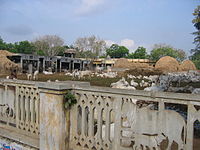 A shelter (goshala) at Guntur
A shelter (goshala) at Guntur
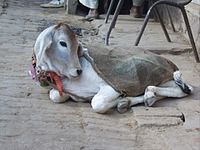 A cow resting on a street in Vrindavan, India, free to wander.
A cow resting on a street in Vrindavan, India, free to wander.
Today, in Hindu-majority countries like India and Nepal, bovine milk holds a key part of religious rituals. For some, it is customary to boil milk on a stove or lead a cow through the house as part of a housewarming ceremony. In honor of their exalted status, cows often roam free, even along (and in) busy streets in major cities such as Delhi. In some places, it is considered good luck to give one a snack, or fruit before breakfast. In places where there is a ban on cow slaughter, a person can be jailed for killing or injuring a cow.[citation needed]
It is a common misconception throughout the Western world that the cow is seen as a god or deity within the Hindu religion.[citation needed] This is used to explain the banning of the slaughter of cows in India.[citation needed] This is not the case, for the reasons discussed above.[citation needed]
The law in India
Slaughter of cattle is allowed with restrictions (like a 'fit-for-slaughter' certificate which may be issued depending on factors like age and gender of cattle, continued economic viability etc.) in fourteen states, it is completely banned in six states, while there is no restriction in four states.[19] Cows are routinely shipped to states with lower or no requirement for slaughter, even though it is illegal in some states to even transport cows for slaughter across provincial borders.[20] Many illegal slaughterhouses operate in large cities such as Chennai and Mumbai. While there are approximately 3,600 slaughterhouses operating legally in India, there are estimated to be over 30,000 illegal slaughterhouses.[21] Efforts to close them down have so far been largely unsuccessful.
In Burma
The beef taboo is fairly widespread in Burma, particularly within the Buddhist community. In Burma, beef is typically obtained from cattle that are slaughtered at the end of their working lives (16 years of age) or from sick animals.[22] Cattle is rarely raised for meat; 58% of cattle in the country is used for draught power.[22] Few people eat beef, and there is a general dislike of beef (especially among the Bamar and Burmese Chinese),[23][24] although it is more commonly eaten in regional cuisines, particularly those of ethnic minorities like the Kachin.[25] Buddhists, when giving up meats during the Buddhist lent (Vassa) or during Uposatha days, will forgo beef first.[26] Almost all butchers are Muslim, not Buddhist, because of the Buddhist doctrine of ahimsa (no harm).[27]
In 1885, Ledi Sayadaw, a prominent Buddhist monk wrote the Nwa-myitta-sa (နွားမေတ္တာစာ), a poetic prose letter that argued that Burmese Buddhists should not kill cattle and eat beef, since Burmese farmers depended on them as beasts of burden to maintain their livelihoods, that the marketing of beef for human consumption threatened the extiction of buffalo and cattle and that the practice and was ecologically unsound.[28] He subsequently led successful beef boycotts during the colonial era, despite the presence of beef eating among locals and influenced a generation of Burmese nationalists in adopting this stance.[28]
On 29 August 1961, the Burmese Parliament passed the State Religion Promotion Act of 1961, which explicitly banned the slaughtering of cattle nationwide (beef became known as todo tha (တိုးတိုးသား); lit. hush hush meat).[29] Religious groups, such as Muslims, were required to apply for exemption licences to slaughter cattle on religious holidays.[30] This ban was repealed a year later, after Ne Win led a coup d'état and declared martial law in the country.
In Zoroastrianism
Zoroastrianism is a religion historically related to Hinduism.
The term "geush urva" means the spirit of the cow and is interpreted as the soul of the earth. In the Ahunavaiti Gatha, Zarathustra (or Zoroaster) accuses some of his co-religionists of abusing the cow.[31] Ahura Mazda tells Zarathustra to protect the cow.[31]
The lands of both Zarathustra and the Vedic priests were those of cattle breeders.[32]
The 9th chapter of the Vendidad of the Avesta expounds the purificatory power of cow urine.[33] It is declared to be a panacea for all bodily and moral evils.[33]
In East Asia
The beef taboo, known as niú jiè (牛戒), has historically been an important dietary restriction in China, particularly among the Han Chinese, as oxen and buffalo (bovines) are useful in farming and are respected.[34][35] During the Zhou Dynasty, they were not often eaten, even by emperors.[36] Some emperors banned killing cows.[37][38] Beef is not recommended in Chinese medicine, as it is considered a hot food and can disrupt the body's internal balance.[39]
In written sources (including anectodes and Daoist liturgical texts), this taboo first appeared in the 9th to 12th centuries (Tang-Song transition, with the advent of pork meat.[40] By the 16th to 17th centuries, the beef taboo had become well accepted in the framework of Chinese morality and was found in morality books (善書), with several books dedicated exclusively to this taboo.[40] The beef taboo comes from a Chinese perspective that relates the respect for animal life and vegetarianism (ideas shared by Buddhism, Confucianism and Daoism, and state protection for draught animals.[40] In Chinese society, only ethnic and religious groups not fully assimilated (such as the Muslim Huis and the Miao) and foreigners consumed this meat.[40] This taboo, among Han Chinese, led Chinese Muslims to create a niche for themselves as butchers who specialized in slaughtering oxen and buffalo.[41]
Some worshippers of Guan Yin do not eat beef.[42] Occasionally, some cows weeping before slaughter, and they are often released to temples nearby.[43][44][45][46][47][48][49][50][51]
Historically, there was a beef taboo in Japan, as a means of protecting the livestock population and Buddhist influence.[52] Meat-eating had long been taboo in Japan, beginning with a decree in 675 that banned the consumption of cattle, horses, dogs, monkeys and chicken, influenced by the Buddhist prohibition of killing.[53] In 1612, the shogun declared a decree that specifically banned the killing of cattle.[53] This official prohibition was in place until 1872, when it was officially proclaimed that Emperor Meiji consumed beef and mutton, which transformed the country's dietary considerations as a means of modernizing the country, particularly with regard to consumption of beef.[53] With contact from Europeans, beef increasingly became popular, even though it had previously been considered barbaric.[52]
In Ancient Egypt
The ancient Egyptians sacrificed animals, but not the cow because it was sacred to goddess Hathor, and also due to the contemporary Greek myth of Io, who had the form of a cow.[54]
In Egyptian mythology, Hesat was the manifestation of Hathor, the divine sky-cow, in earthly form. Like Hathor, she was seen as the wife of Ra. In hieroglyphs she is depicted as a cow with a hat.
In Ancient Europe
- Among the Ancient Scandinavians, the Holiest Cow Auðumbla was the one that suckled the Gods.
- Among the Visigoths, the Oxen pulling the wagon with the corpse of Saint Emilian lead to the correct burial site (San Millán de la Cogolla, La Rioja).
- At Saint Fernando's death, the bulls of the Muslims bowed as his body went to burial.[citation needed]
See also
- Kamadhenu
- Khnum
- Nandi (bull)
- Panchamrit
- Red heifer
- Shambo
- Zebu, the common breed of cow from India
Notes
- ^ Jha, Dwijendra Narayan. The Myth of the Holy Cow. London/New York: Verso 2002
- ^ (Achaya 2002, pp. 16–17)
- ^ http://baike.foyuan.net/doc-view-19967.html
- ^ V.M. Apte, Religion and Philosophy, The Vedic Age
- ^ (e.g. RV 1.126.3; 1.164.3; 5.27.1; 8.1.33; 8.2.41; 8.4.20; 8.5.37; 8.6.47; 8.21.18; 9.69.4)
- ^ a b Sethna 1992:42
- ^ RV 4.41.5, 10.75.3–4
- ^ (RV 1.92.4; 4.52.5; 7.79.2), Aurobindo: The Secret of the Veda; Sethna 1992
- ^ Atharvaveda 9.7
- ^ Manusmrti chapter 3, verses 266–272
- ^ (Achaya 2002, p. 55)
- ^ "milking of the Earth". Texts.00.gs. http://texts.00.gs/milking_the_Earth-cow.htm. Retrieved 13 November 2011.
- ^ Brahmavaivarta Purāṇa 4.21.91–97
- ^ Biardeau, Madeleine (1993). "Kamadhenu: The Mythical Cow, Symbol of Prosperity". In Yves Bonnefoy. Asian mythologies. University of Chicago Press. p. 99. ISBN 0-226-06456-5.
- ^ Smith, Frederick M. (2006). The self possessed: Deity and spirit possession in South Asian literature and civilization. Columbia University Press. pp. 404, pp. 402–3 (Plates 5 and 6 for the two representations of Kamadhenu). ISBN 978-0-231-13748-5.
- ^ R. Venugopalam (2003). "Animal Deities". Rituals and Culture of India. B. Jain Publishers. pp. 119–120. ISBN 81-8056-373-1.
- ^ W. and R. Chambers (1891). Chambers's Encyclopaedia: A Dictionary of Universal Knowledge for the People. 8. p. 719. http://books.google.com/books?id=vUJMAAAAMAAJ.
- ^ a b c "Compilation of Gandhi's views on Cow Protection". Dahd.nic.in. 7 July 1927. http://dahd.nic.in/ch2/an2.6.htm. Retrieved 13 November 2011.
- ^ "ANNEX II (8)". Dahd.nic.in. 30 August 1976. http://www.dahd.nic.in/dahd/reports/report-of-the-national-commission-on-cattle/chapter-ii-executive-summary/annex-ii-8.aspx. Retrieved 13 November 2011.
- ^ Rahman, Maseeh (2000-05-29). "Is Nothing Sacred?". Time Asia. http://www-cgi.cnn.com/ASIANOW/time/magazine/2000/0529/india.cows.html. Retrieved 2008-02-25.
- ^ "Sacred No Longer". Advocates for Animals. Summer 2004. Archived from the original on 2004-10-13. http://web.archive.org/web/20041013220300/http://www.advocatesforanimals.org.uk/campaigns/farmed/cattle/indianleather.html. Retrieved 2008-02-25.
- ^ a b Devendra,, C.; Devendra, C.,Thomas, D.,Jabbar, M.A.,Kudo, H., Thomas, D., Jabbar, M.A., Kudo, H.. Improvement of livestock production in crop-animal systems in rainfed agro-ecological zones of South-East Asia. ILRI. p. 33.
- ^ Gesteland, Richard R.; Georg F. Seyk (2002). Marketing across cultures in Asia. Copenhagen Business School Press DK. p. 156. ISBN 9788763000949.
- ^ U Khin Win (1991). A century of rice improvement in Burma. International Rice Research Institute. pp. 27, 44. ISBN 9789712200243.
- ^ Meyer, Arthur L.; Jon M. Vann (2003). The Appetizer Atlas: A World of Small Bites. John Wiley and Sons. p. 276. ISBN 9780471411024.
- ^ Simoons, Frederick J. (1994). Eat not this flesh: food avoidances from prehistory to the present. Univ of Wisconsin Press. p. 120. ISBN 9780299142544.
- ^ Spiro, Melford (1982). Buddhism and society: a great tradition and its Burmese vicissitudes. University of California Press. p. 46. ISBN 0520046722.
- ^ a b Charney, Michael (2007). "Demographic Growth, Agricultural Expansion and Livestock in the Lower Chindwin in the Eighteenth and Nineteenth Centuries". In Greg Bankoff, P. Boomgaard. A history of natural resources in Asia: the wealth of nature. MacMillan. pp. 236–40. ISBN 9781403977366.
- ^ King, Winston L. (2001). In the hope of Nibbana: the ethics of Theravada Buddhism. 2. Pariyatti. p. 295. ISBN 9781928706083.
- ^ Bisht, Narendra S.; T. S. Bankoti (2004). Encyclopaedia of the South East Asian Ethnography. Global Vision Publishing House. ISBN 9788187746966.
- ^ a b Clark, P. 13 Zoroastrianism
- ^ Vogelsang, P. 63 The Afghans
- ^ a b P. 72 Some Aspects of Ancient Indian Culture By D. R. Bhandarkar
- ^ http://www.chinafolklore.org/blog/?uid-35-action-viewspace-itemid-4188
- ^ Katz, Paul R. (2008). Divine justice: religion and the development of Chinese legal culture. Academia Sinica on East Asia. Taylor & Francis US. p. 56. ISBN 9780415443456.
- ^ Classic of Rites
- ^ 民間私營養牛業(附私營牧駝業)[dead link]
- ^ http://www.eywedu.com/Huizuyanjiu/hzyj2007/hzyj20070208.html
- ^ Hutton, Wendy (2007). Singapore food. Marshall Cavendish. p. 144. ISBN 9789812613219.
- ^ a b c d Sterckx, Roel (2005). Of tripod and palate: food, politics and religion in traditional China. Macmillan. pp. 237-. ISBN 9781403963376.
- ^ Elverskog, Johan (2010). Buddhism and Islam on the Silk Road. University of Pennsylvania Press. p. 240. ISBN 9780812242379.
- ^ Daniels, Timothy P. (2005). Building cultural nationalism in Malaysia: identity, representation, and citizenship. Psychology Press. p. 149. ISBN 9780415949712.
- ^ 慈雲閣——看靈牛遊地獄
- ^ "公牛拜人图". Superwork.com. http://www.superwork.com/ox1.htm. Retrieved 13 November 2011.
- ^ 生命的跪拜[dead link]
- ^ "萬善先資集". Foshu.net. http://www.foshu.net/books2/1283.htm. Retrieved 13 November 2011.
- ^ 孝友鑒第一
- ^ "母羊被宰前突然含淚產小羊". Tw.myblog.yahoo.com. 20 August 1996. http://tw.myblog.yahoo.com/jw!C5kYndqBA0WxcUXSmsavZA--/article?mid=4708&sc=1. Retrieved 13 November 2011.
- ^ "一段觸目驚心的故事-震驚". Fengshui-chinese.com. http://www.fengshui-chinese.com/discuz/viewthread.php?action=printable&tid=42046. Retrieved 13 November 2011.
- ^ 发生在我身边的真实轮回
- ^ "Bighearted butchers spare weeping water buffalo". Google Books. 28 May 1996. http://books.google.com/books?id=lPEDAAAAMBAJ&pg=PA26&lpg=PA26. Retrieved 13 November 2011.
- ^ a b Cwiertka, Katarzyna Joanna (2006). Modern Japanese cuisine: food, power and national identity. Reaktion Books. ISBN 9781861892980.
- ^ a b c Lien, Marianne E.; Brigitte Nerlich (2004). The politics of food. Berg. pp. 125–127. ISBN 9781859738535.
- ^ P. 57 Analysis and summary of Herodotus, with a synchronistical table of principal events; tables of weights, measures, money, and distances; an outline of the history and geography; and the dates completed from Gaisford, Baehr, etc., by J. Talboys Wheeler By James Talboys Wheeler
References
- Achaya, K. T. (2002), A Historical Dictionary of Indian Food, Oxford University Press, ISBN 0-19-565868-X.
- K. D. Sethna, The Problem of Aryan Origins 1980, 1992; ISBN 81-85179-67-0
- Shaffer, Jim G. (1995). Cultural tradition and Palaeoethnicity in South Asian Archaeology. In: Indo-Aryans of Ancient South Asia. Ed. George Erdosy. ISBN 3-11-014447-6
- Shaffer, Jim G. (1999). Migration, Philology and South Asian Archaeology. In: Aryan and Non-Aryan in South Asia. Ed. Bronkhorst and Deshpande. ISBN 1-888789-04-2.
External links
- Photo essay examining the changing place of the Holy Cow in India
- Cows in Hinduism
- Sacredness of cow in Rigveda and the words of Gandhi, from Hinduism Today
- Milk in a vegetarian diet, from Sanatan Society, a Hindu association
- Sacred No Longer: The suffering of cattle for the Indian leather trade, from Advocates for Animals
- Rise In Animal Slaughter in India, by Tony Mathews
- "Pamela Anderson Lee Exposes Animal Cruelty in the International Leather Trade", from PETA
- Deonar Abattoir: Report on the Failure of Government and of Management to Meet Humane, Hygiene, Religious, and Legal Standards for Slaughter and Animal Handling, from PETA
- People for Animals, an Indian animal rights organisation
- India cow report, by Balabhadra das, ISCOWP
- Hinduism: Why do Hindus regard the cow as sacred?
- The street life of Indian 'Desi' cows
- [1]
Categories:- Cattle
- Hindu philosophical concepts
- Indian culture
- Animal worship
- Animals in religion
Wikimedia Foundation. 2010.

